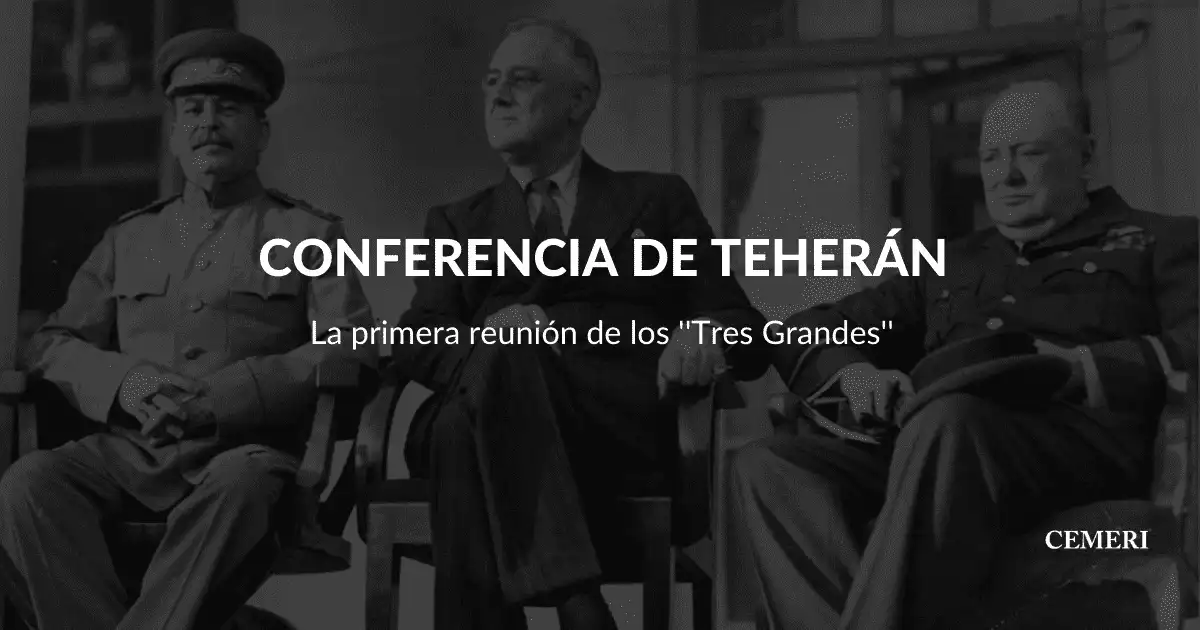Encyclopedia
Marco Antonio Olivera Eslava
Tehran conference: the first meeting of the ''Big Three''
- It was a meeting in 1943 between Stalin, Churchill, and Roosevelt in which they coordinated their military strategy against Germany and Japan in World War II.

The Tehran Conference was a meeting that took place between November 28 and December 1, 1943 in the Persian city of Tehran, between the leaders Iosif Stalin, Winston Churchill and Franklin D. Roosevelt, who formed the Allied side. During the Conference, the three leaders coordinated their military strategy against Germany and Japan and made a number of important decisions related to the post-World War II era.
Churchill had met Roosevelt and Stalin separately on previous occasions, but the summit marked the first face-to-face meeting between the American and Soviet leaders. In addition, it was the first conference between the big three (the Soviet Union, the United States, and the United Kingdom) in which Roosevelt was present, since he did not attend the Moscow conference of August 1942 The Tehran Conference happened close to the Cairo conference which took place on November 22-26, 1943, it was also followed by the Yalta Conference (1945) and the Potsdam Conference (1945).
Although the leaders came to the conference with different objectives, the main debate centered on the opening of a second front in Western Europe, the USSR's declaration of war on Japan and the approach to the demilitarization of Germany and the division Of the same.
The conference also covered Allied relations with Turkey and Iran and operations in Yugoslavia.
After months of negotiation, the Big Three finally meet in Tehran, on November 29, 1943.
Photo: Stevenson Library Digital Collections.
Context of World War II
Roosevelt and Churchill had just emerged from the first Cairo Conference, which laid out the future strategy to be followed against Japan at the end of a year of sustained successes by the United States, Britain, and Australia in Southeast Asia, including major offensives. in Burma and numerous landings in Japanese-occupied territories throughout the theater of operations.
On the Eastern Front, Hitler's army had suffered a series of major setbacks in 1943, beginning with the destruction of General Friedrich von Paulus's Sixth Army in the bloody Battle of Stalingrad and the loss of some 250,000 German soldiers. at the time of the capitulation in February.
During July and August of that same year, the German forces suffered several blows in the battles of Kursk, Orel and Kharkov, where the Soviet forces managed to prevail.
In the Mediterranean, Italian Benito Mussolini's vainglorious dreams of establishing a modern Roman Empire had been shattered by Allied attacks on Sicily in July and on the Italian mainland in September, leading to the *collapse of the Fascist regime * and desperate German attempts to save their southern defenses by occupying northern Italy.
In Africa, Hitler's last foothold in the north of the continent had already been lost in May with the occupation of Tunisia by Anglo-American forces.
In this context of a decisive change in the course of the war in favor of the Allies, the leaders of the "Big Three", together with their main military and diplomatic advisers, met in the Persian capital to define the future of war.
Procedure
Organizing the Conference was somewhat complicated. Roosevelt had tried on a few occasions to meet with Stalin, but the Soviet leader, who according to US intelligence reports was concerned about possible threats to his life and afraid to fly, had always refused.
When Stalin finally agreed, Churchill proposed a meeting in London, but the former insisted that the meeting take place in Tehran, then under joint Soviet-UK control. That distant and relatively secluded location made things difficult for Churchill, but especially for Roosevelt who, as president, had to travel 7,000 miles and whose health was already deteriorating. In addition to the fact that he could not be absent for more than 10 days when Congress was in session, because in case of absence, the approved bills would become law without his signature, without even giving him the opportunity to exercise his power to veto.
President Franklin D. Roosevelt and General Dwight D. Eisenhower in presidential plane heading to the Tehran Conference.
Finally, Stalin, who was flying for the first time in his life, got there first. Roosevelt and Churchill arrived after the Cairo Conference ended.
The Shah, 22-year-old Mohammad Reza Pahlavi, had only protocol power and was informed about the Conference only a few days in advance. On top of that, the Shah was not even invited to the ceremonies that took place in the embassies.
Despite all the difficulties in concluding the meeting, it was carried out and several important agreements were reached.
Operation Overlord
Initial talks about Operation Overlord were discussed at the Moscow conference in October before the Big Three meeting in Tehran. However, it was not until this Conference in 1943 that Roosevelt, Churchill, and Stalin engaged in discussions over the terms under which the British and Americans finally agreed to launch Operation Overlord, an invasion of northern France, which was would execute in May 1944. This operation would begin with the Normandy landings, better known as D-Day.
The Soviets, who had been pressing the Allies since 1941 to open a second front, agreed to launch another major offensive on the Eastern Front that would divert German troops from the Allied campaign in northern France.
Declaration of War on Japan by the Soviet Union
Stalin also agreed in principle that the Soviet Union would declare war on Japan after an Allied victory over Germany. In exchange for a Soviet declaration of war against Japan, Roosevelt conceded Stalin's claims to the Kuril Islands and the southern half of Sakhalin Island, as well as access to the ice-free ports of Dalian and Lüshunkou ( Lüshun, formerly Port Arthur) located on the Liaodong Peninsula in northern China. However, the exact details about this agreement were not agreed upon until the Yalta Conference of 1945.
Partition of Germany and the fate of Eastern Europe
During this conference, the three leaders discussed important issues related to Germany and Eastern Europe after the war was over and victory was secured.
Stalin, Churchill and Roosevelt raised the issue of the possible partition of Germany into Allied occupation zones and agreed that the issue of partition should be studied by the European Advisory Commission before making a final decision.
Stalin pushed for the revision of Poland's eastern border with the Soviet Union to coincide with the line established by British Foreign Secretary Lord Curzon in 1920. To compensate Poland for the resulting loss of territory , the ''Big Three'' agreed to move the German-Polish border. to the Oder and Neisse rivers. Stalin agreed, giving the Poles industrialized German land to the west and ceding swampland to the east while providing a buffer zone for the Soviet Union against any kind of invasion. However, this decision was not formally ratified until the Potsdam Conference of 1945.
During the meeting, Roosevelt had to negotiate with Stalin so that the latter would give him his guarantee that the Republics of Estonia, Latvia and Lithuania would rejoin the Soviet Union only if the citizens of each country decided in a referendum. . Stalin stressed, however, that the matter would have to be resolved under the Soviet constitution and that he would not consent to any international control over the elections.
International Cooperation: United Nations Organization
During the Tehran Conference, wider international cooperation also became a central theme of the negotiations. During the Moscow Conference of Foreign Ministers in October and November 1943, the United States, Great Britain, China, and the Soviet Union had signed a four-power declaration whose fourth point called for the creation of an international organization designed to promote peace. and international security. In Tehran, Roosevelt and Stalin met privately as the US president outlined to Stalin his vision of the proposed organization in which the future [United Nations](https://cemeri.org/art /un-importance-and-achievements-75-anniversary/) would be dominated by “four policemen” (United States, United Kingdom, China and the Soviet Union). These countries would have the power to deal with any threat to peace and avoid any confrontation.
Draft of the United Nations, signed and dated by Franklin D. Roosevelt at the Tehran Conference.
Photo: Stevenson Library Digital Collections.
The Three Power Declaration on Iran
A final area of discussion during the conference was this statement in which the three countries thanked Iran for its cooperation in the war against Germany and promised to provide financial assistance to the Persian country both during and after the war. The American, British, and Soviet governments also expressed a desire to maintain Iran's territorial integrity, independence, and sovereignty.
Türkiye and Yugoslavia
As for the operations in the occupied Balkans, the Allies agreed to support, with supplies, soldiers and military equipment, the communist partisans in Yugoslavia led by Tito instead of the loyalist group of Chetniks obedient to the Yugoslav government in exile in London.
Meanwhile, Turkey should join the war, on the side of the allies, before the end of the year. If Turkey went to war against Germany, and if it resulted in a declaration of war or an attack by Bulgaria on Turkey, the USSR would immediately go to war against Bulgaria in support of Turkey. The Conference noted that this could be mentioned in future negotiations to bring Turkey into the war.
The Big Three celebrating Winston Churchill's 69th birthday at the Tehran Conference, November 30, 1943.
Photo: Stevenson Library Digital Collections.
Results
It is said that Stalin came out of the Conference the best, as he obtained important concessions that would be confirmed during subsequent wartime conferences: he achieved an agreement to expand the border of the Soviet Union into the former Polish territory, which saw as a way to create a buffer zone between your country and Germany; The United States and the United Kingdom would accept the dominance of the USSR in Eastern Europe and, also, the first two countries would support the Yugoslav partisans.
** Roosevelt achieved important goals and wishes that he set out during the conference **. One of the main objectives achieved was the commitment of the Soviet Union to join the war against Japan and, in addition, Stalin expressed his support for Roosevelt's plans for the formation of the United Nations.
Most importantly, Roosevelt believed he had gained Stalin's trust and support by demonstrating that the United States was willing to negotiate directly with the Soviet Union and make it an ally, primarily when Roosevelt agreed to open the First and Second Fronts in France. (in the spring of 1944).
Finally, Churchill was the one who came out in the least favorable political position regarding the benefits of the war, since he failed in his main mission of postponing D-Day, in addition to not obtaining the go-ahead to launch an invasion of southern France. (operation that he sought to take advantage of to secure his interests in the Mediterranean).
A confident Stalin walking towards the conference table in Tehran, December 1, 1943.
Photo: Stevenson Library Digital Collections.
Sources
Pedir a Marco

